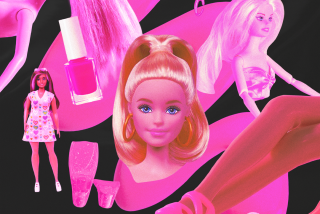Pink Does Not the Girl (or Boy) Make
Surveying the heap of unidentifiable plastic toy parts, doll limbs and stuffed animals in her daughter’s room, the mother sadly noted that with Christmas fewer than two months gone, it was already impossible to remember what Santa had brought.
Was that pink Minnie Mouse umbrella new? Or had the child owned it forever?
What about the pink dolly stroller? It was missing a couple of wheels, but most of the Christmas toys had fallen apart before New Year’s, hadn’t they?
And what was with all the pink stuff anyhow?
This child, the mother had sworn, was not going to have her femininity forced upon her. She would not be swaddled in pink. Barbie would be neither her physical role model nor her constant companion. And no one, nohow, was going to call this kid “princess.”
Easier to fight the moon’s pull on the tides.
All the baby hand-me-downs were bordered in lace and tied up in pink bows. Her first busty blond doll was sneaked under the tree by a doting relative.
And as for royal nicknames--princess, schmincess.
Last weekend, incarcerated by the rain, the mother and her daughter baked a batch of oatmeal cookies, then hosted a tea for the stuffed animals in the living room.
“OK, Mommy,” said the girl as she poured a cup, “you are Your Majesty, and I am the Fween of England.”
Indeed. With the title of princess sullied by tales of marital discord, eating disorders and self-mutilation, who can blame the child for aiming a few rungs higher?
*
Before I became a parent, I had a lot of fascinating theories about children and gender identity. I thought by careful clothing, toy and video selection, a parent could actually exercise some sort of influence on how a girl expresses her femininity.
Part of my job would be to protect her from gender stereotyping, to correct her thinking when she announced, “Only girls cook,” or, “Only boys hit.” (But that’s hypocritical, since I make those judgments all the time, and for the last 15 years have vainly tried to convince her father that “Only boys take out the garbage.”)
Trying to fight chromosomes is not only pointless but stupid. Much of the attraction of girls to pink, as far as I can tell, is biological and will out no matter what. Anyhow, I want her to love being a girl as much as I do.
My child has never seen “Mighty Morphin Power Rangers” on television, but she possesses detailed knowledge of these B-grade teen characters. I suspect she comes by her facts courtesy of the toddler underground at the local park.
The other day, as she chopped the air with karate blows, she announced with utter confidence: “I am a Powder Ranger! . . . I am the PINK Powder Ranger.”
“That’s right!” I was horrified to hear myself say.
My job is to help her navigate the world as safely as possible, to guide her as she grows into a self-possessed creature who is compassionate and independent.
It is not my responsibility to raise her in a pink-free environment.
This, I imagine, is where Angelyne’s parents went wrong.
*
We recently found ourselves in a toy store, my kid and I, bedazzled by the sheer pinkness of the girl toy aisles. Now here is a place where the gender lines are drawn in indelible ink.
In girl aisles, you find infinite numbers of dolls and games such as “Sealed With a Kiss,” where the object is to stamp a kiss on a picture of a “hunk” more times than the other girls, and “Dream Phone,” a (what else) pink plastic telephone for dialing a girl’s “secret admirer.”
Boy aisles are dark and “dolls” is a dirty word. (“Action figure,” to you, pal.) You will not find games in the boy aisles that involve dates, kisses or romance in any form.
What this tells us about our children is what we already know: that girls judge themselves by their relationships to peers and others, while boys judge themselves by how much Gak they can shove up the other kid’s nose before he stops breathing.
As I stood at a wall of Disney-based toys, immersed in my Pocahontas dilemma (Should I buy my daughter the fake buckskin dress? / Would John Smith be attracted to me?), somebody’s daddy approached.
Inside his shopping cart was a big cardboard box that held a pink toy shopping cart.
“Excuse me,” he said, looking worried. “Do you think I will ruin a boy by giving this to him?” He gestured at the pink cart.
I thought he was joking. But the look on his face telegraphed a faith in the universe of uncrossable gender lines, where girls shop in pink aisles and boys shop in dark aisles and woe to the (father of the) child who goes astray.
I laughed: “Hey, you’re pushing a cart and you aren’t ruined!”
But I understood his concern. What he wanted was reassurance: No, mister, just because your kid pushes a pink cart doesn’t mean he’ll want to be the Fween of England.
* Robin Abcarian’s column appears Wednesdays and Sundays. Readers may write to her at the Los Angeles Times, Life & Style, Times Mirror Square, Los Angeles, CA 90053.







